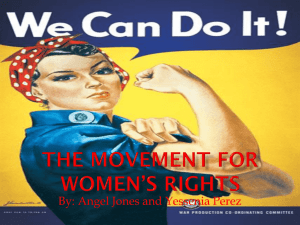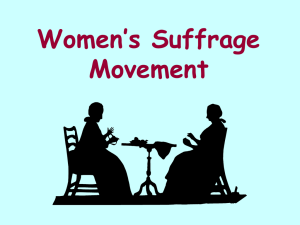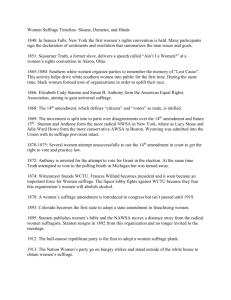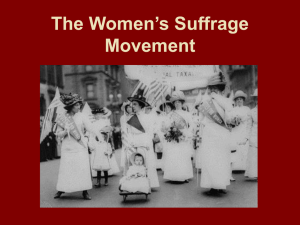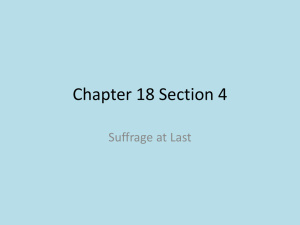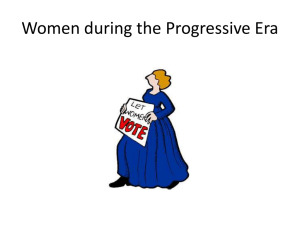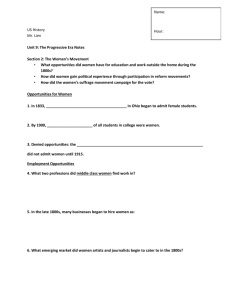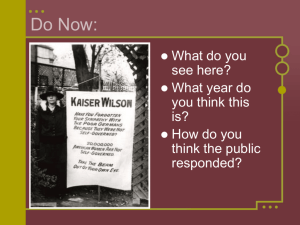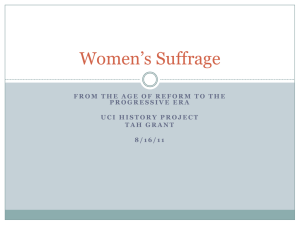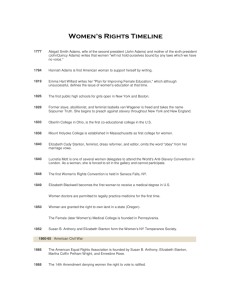Women's History
advertisement
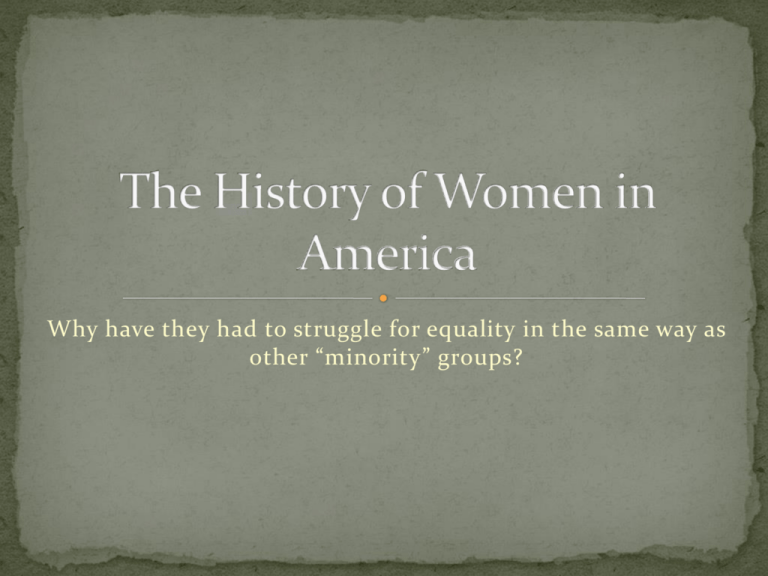
Why have they had to struggle for equality in the same way as other “minority” groups? "Remember, all men would be tyrants if they could. If particular care and attention is not paid to the ladies, we are determined to foment a rebellion, and will not hold ourselves bound by any laws in which we have no voice or representation.” Times of War When husbands died, if sons weren’t old enough They were skilled craftswomen, talented parents, religious thinkers, resourceful women who could take over their husbands' duties and continue to perform their own. And, in the Revolution they proved they were politically aware — and many were active patriots, fighting for independence. The roles of white women and Indian women and the power they had were vastly different. Captured white women often preferred life with the Indian tribe to life in Colonial society because they had more power. could instruct their children, sons especially, to be intelligent and reasonable individuals. This heightened significance to a traditional aspect of wives' duties brought with it a new commitment to female education and helped make husbands and wives more equal within the family. The benefits that accompanied this new ideal of motherhood were largely restricted to elite families that had the resources to educate their daughters and to allow wives to not be employed outside the household. Republican motherhood did not meaningfully extend to white working women and was not expected to have any place for enslaved women. White women came to possess a new social power as moral reformers and were thought to possess more Christian virtue than men, but this idealization simultaneously limited white middle-class women to a restricted domestic sphere. 1820s and 1830s: women began to displace men as the overwhelming majority of schoolteachers The husband had to be out in the public sphere creating the wealth, but his wife was free to manage the private sphere, the "WOMEN'S SPHERE." Together, a successful husband and wife created a picture of perfect harmony. A TRUE WOMAN was virtuous. Her four chief characteristics were piety, purity, submissiveness and domesticity. She was the great civilizer who created order in the home in return for her husband's protection, financial security and social status. It was a fragile existence for a woman. One indiscretion, trivial by today's standards, would be her downfall, and there was no place in polite society for a fallen woman. During the era of the "CULT OF DOMESTICITY," a woman was seen merely as a way of enhancing the social status of her husband. By the 1830s and 40s, however, the climate began to change when a number of bold, outspoken women championed diverse social reforms of prostitution, capital punishment, prisons, war, alcohol, and, most significantly, slavery. Under the leadership of Elizabeth Cady Stanton, Lucretia Mott, and Susan B. Anthony, the Seneca Falls convention demanded improved laws regarding child custody, divorce, and property rights. They argued that women deserved equal wages and career opportunities in law, medicine, education and the ministry. First and foremost among their demands was SUFFRAGE — the right to vote. In this era of reform and renewal women realized that if they were going to push for equality, they needed to ignore criticism and what was then considered acceptable social behavior. Organized by Mott and Stanton A convention to discuss the "social, civil and religious condition and rights of women." 200 women, 40 men Thereafter, national women's conventions were held annually Passed 11 resolutions, the 9th being "the duty of women to secure for themselves the right to elective franchise" (only resolution that was NOT unanimous!) Activity: comparison of the Declaration of Independence & the Declaration of Sentiments You will be given copies of both of these documents, and after reading each you will look for similarities in language and purpose. In 1813, FRANCES CABOT LOWELL, NATHAN APPLETON and PATRICK JOHNSON formed the BOSTON MANUFACTURING COMPANY to build America's first integrated textile factory, that performed every operation necessary to transform cotton lint into finished cloth. They built their production facilities at Massachusetts. To work in the textile mills, Lowell hired young, unmarried women from New England farms. The "MILL GIRLS" were chaperoned by matrons and were held to a strict curfew and moral code. Although the work was tedious (12 hours per day, 6 days per week), many women enjoyed a sense of independence they had not known on the farm. The wages were about triple the going rate for a domestic servant at the time. An opportunity for independence and freedom (from parents and for economic) OR a slave-type system with harsh conditions And some criticized it as a challenge to traditional women's roles Dear Father, I received your letter on Thursday the 14th with much pleasure. I am well, which is one comfort. My life and health are spared while others are cut off. Last Thursday one girl fell down and broke her neck, which caused instant death. She was going in or coming out of the mill and slipped down, it being very icy. The same day a man was killed by the [railroad] cars. Another had nearly all of his ribs broken. Another was nearly killed by falling down and having a bale of cotton fall on him. Last Tuesday we were paid. In all I had six dollars and sixty cents paid $4.68 for board. With the rest I got me a pair of rubbers and a pair of 50 cent shoes. Next payment I am to have a dollar a week beside my board... I think that the factory is the best place for me and if any girl wants employment, I advise them to come to Lowell. -Excerpt from a Letter from Mary Paul, Lowell mill girl, December 21, 1845. http://www.history.com/topics/industrial- revolution/videos/characteristics-of-early-factorygirls?m=528e394da93ae&s=undefined&f=1&free=false Activists such as FREDERICK DOUGLASS, LUCY STONE, and HENRY BLACKWELL argued that the 1860s was the time for the black male. Linking black suffrage with female suffrage would surely accomplish neither. SUSAN B. ANTHONY, ELIZABETH CADY STANTON, and SOJOURNER TRUTH disagreed. They would accept nothing less than immediate federal action supporting the vote for women. Bitter disappointment: the word "male" is in the 14th amendment Anthony and Stanton formed the NATIONAL WOMAN SUFFRAGE ASSOCIATION and pressed for a constitutional amendment. The NWSA was known to show up to the polls on election day to force officials to turn them away. They set up mock ballot boxes near the election sites so women could "vote" in protest. The AWSA chose a much more understated path. Stone and Blackwell actively lobbied state governments. WYOMING became the first state to grant full women's suffrage in 1869, and UTAH followed suit the following year. Temperance Settlement Houses— where destitute immigrants could go when they had nowhere else to turn. Settlement houses provided family-style cooking, lessons in English, and tips on how to adapt to American culture. Many single, middle-class women took jobs in the new cities. Clerical jobs opened as typewriters became indispensable to the modern corporation. The telephone service required switchboard operators and the new department store required sales positions. Many of these women found themselves feeling marvelously independent, despite the lower wages they were paid in comparison with their male counterparts. But not much independence occurred for lower class working women, immigrants, and former slaves, now sharecroppers. A devout feminist, Woodhull protested the male hold on politics by running for President in 1872. She became the first female American to do so in a time when women did not even enjoy the right to vote. (no one knows how many votes she got because they didn't even bother to count them!!) The two groups formed the NATIONAL AMERICAN WOMAN SUFFRAGE ASSOCIATION (NAWSA). The fight to victory was conducted by CARRIE CHAPMAN CATT. By 1910, most states west of Mississippi had granted full suffrage rights to women. States of the Midwest at least permitted women to vote in Presidential elections. But the Northeast and the South were steadfast in opposition. Catt knew that to ratify a national amendment, NAWSA would have to win a state in each of these key regions. Once cracks were made, the dam would surely burst. “For the safety of the Nation To the Women Give the Vote For the hand that Rocks the Cradle Will Never Rock the Boat!” Before SignOn.org, Twitter or Facebook, these women collected more than a million signatures in pen and ink, all through hand-to-hand contact, and displayed them as they marched down Fifth Avenue in New York with 20,000 supporters and an estimated half-million people in the crowd in 1917. https://www.youtube.com/watch?v=pO70ZjZ0wrw Amid the backdrop of the United States entry into World War I, success finally came. In 1917, New York and Arkansas permitted women to vote, and momentum shifted toward suffrage. NAWSA supported the war effort throughout the ratification process, and the prominent positions women held no doubt resulted in increased support. On August 26, 1920, the NINETEENTH AMENDMENT became the supreme law of the land, and the long struggle for voting rights was over. https://www.youtube.com/watch?v=IYQhRCs9IHM Written, directed & produced by Bradley Hart 1st assistant director: Sara Peyton
